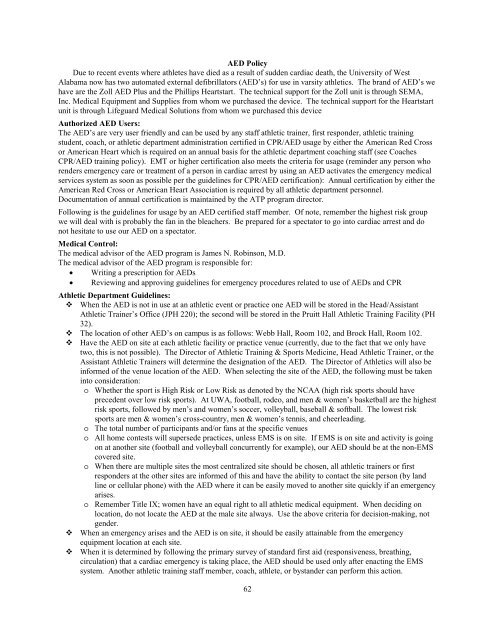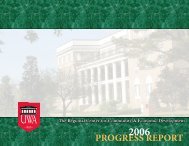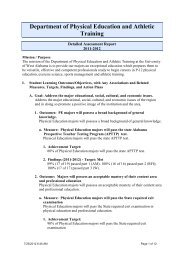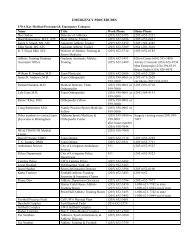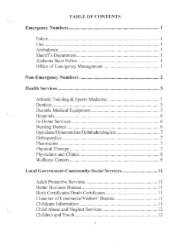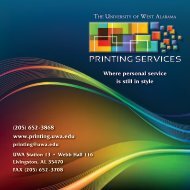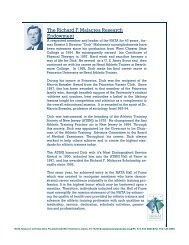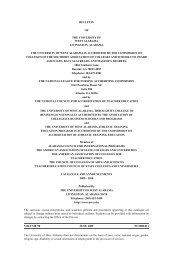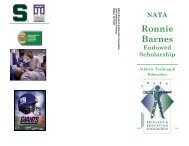table of contents - UWA Athletic Training & Sports Medicine Center
table of contents - UWA Athletic Training & Sports Medicine Center
table of contents - UWA Athletic Training & Sports Medicine Center
Create successful ePaper yourself
Turn your PDF publications into a flip-book with our unique Google optimized e-Paper software.
AED PolicyDue to recent events where athletes have died as a result <strong>of</strong> sudden cardiac death, the University <strong>of</strong> WestAlabama now has two automated external defibrillators (AED’s) for use in varsity athletics. The brand <strong>of</strong> AED’s wehave are the Zoll AED Plus and the Phillips Heartstart. The technical support for the Zoll unit is through SEMA,Inc. Medical Equipment and Supplies from whom we purchased the device. The technical support for the Heartstartunit is through Lifeguard Medical Solutions from whom we purchased this deviceAuthorized AED Users:The AED’s are very user friendly and can be used by any staff athletic trainer, first responder, athletic trainingstudent, coach, or athletic department administration certified in CPR/AED usage by either the American Red Crossor American Heart which is required on an annual basis for the athletic department coaching staff (see CoachesCPR/AED training policy). EMT or higher certification also meets the criteria for usage (reminder any person whorenders emergency care or treatment <strong>of</strong> a person in cardiac arrest by using an AED activates the emergency medicalservices system as soon as possible per the guidelines for CPR/AED certification): Annual certification by either theAmerican Red Cross or American Heart Association is required by all athletic department personnel.Documentation <strong>of</strong> annual certification is maintained by the ATP program director.Following is the guidelines for usage by an AED certified staff member. Of note, remember the highest risk groupwe will deal with is probably the fan in the bleachers. Be prepared for a spectator to go into cardiac arrest and donot hesitate to use our AED on a spectator.Medical Control:The medical advisor <strong>of</strong> the AED program is James N. Robinson, M.D.The medical advisor <strong>of</strong> the AED program is responsible for:• Writing a prescription for AEDs• Reviewing and approving guidelines for emergency procedures related to use <strong>of</strong> AEDs and CPR<strong>Athletic</strong> Department Guidelines: When the AED is not in use at an athletic event or practice one AED will be stored in the Head/Assistant<strong>Athletic</strong> Trainer’s Office (JPH 220); the second will be stored in the Pruitt Hall <strong>Athletic</strong> <strong>Training</strong> Facility (PH32). The location <strong>of</strong> other AED’s on campus is as follows: Webb Hall, Room 102, and Brock Hall, Room 102. Have the AED on site at each athletic facility or practice venue (currently, due to the fact that we only havetwo, this is not possible). The Director <strong>of</strong> <strong>Athletic</strong> <strong>Training</strong> & <strong>Sports</strong> <strong>Medicine</strong>, Head <strong>Athletic</strong> Trainer, or theAssistant <strong>Athletic</strong> Trainers will determine the designation <strong>of</strong> the AED. The Director <strong>of</strong> <strong>Athletic</strong>s will also beinformed <strong>of</strong> the venue location <strong>of</strong> the AED. When selecting the site <strong>of</strong> the AED, the following must be takeninto consideration:o Whether the sport is High Risk or Low Risk as denoted by the NCAA (high risk sports should haveprecedent over low risk sports). At <strong>UWA</strong>, football, rodeo, and men & women’s basketball are the highestrisk sports, followed by men’s and women’s soccer, volleyball, baseball & s<strong>of</strong>tball. The lowest risksports are men & women’s cross-country, men & women’s tennis, and cheerleading.o The total number <strong>of</strong> participants and/or fans at the specific venueso All home contests will supersede practices, unless EMS is on site. If EMS is on site and activity is goingon at another site (football and volleyball concurrently for example), our AED should be at the non-EMScovered site.o When there are multiple sites the most centralized site should be chosen, all athletic trainers or firstresponders at the other sites are informed <strong>of</strong> this and have the ability to contact the site person (by landline or cellular phone) with the AED where it can be easily moved to another site quickly if an emergencyarises.o Remember Title IX; women have an equal right to all athletic medical equipment. When deciding onlocation, do not locate the AED at the male site always. Use the above criteria for decision-making, notgender. When an emergency arises and the AED is on site, it should be easily attainable from the emergencyequipment location at each site. When it is determined by following the primary survey <strong>of</strong> standard first aid (responsiveness, breathing,circulation) that a cardiac emergency is taking place, the AED should be used only after enacting the EMSsystem. Another athletic training staff member, coach, athlete, or bystander can perform this action.62


